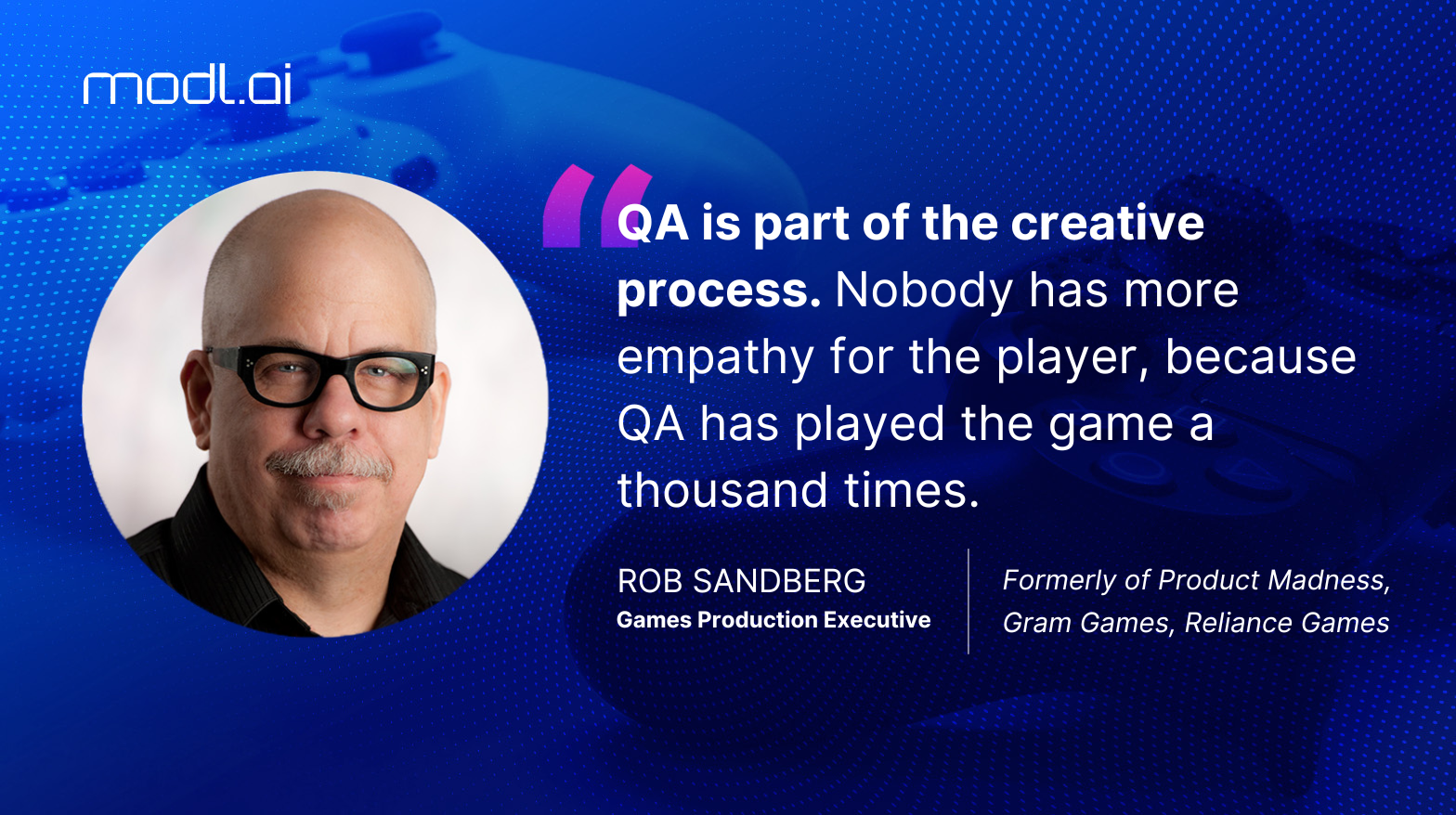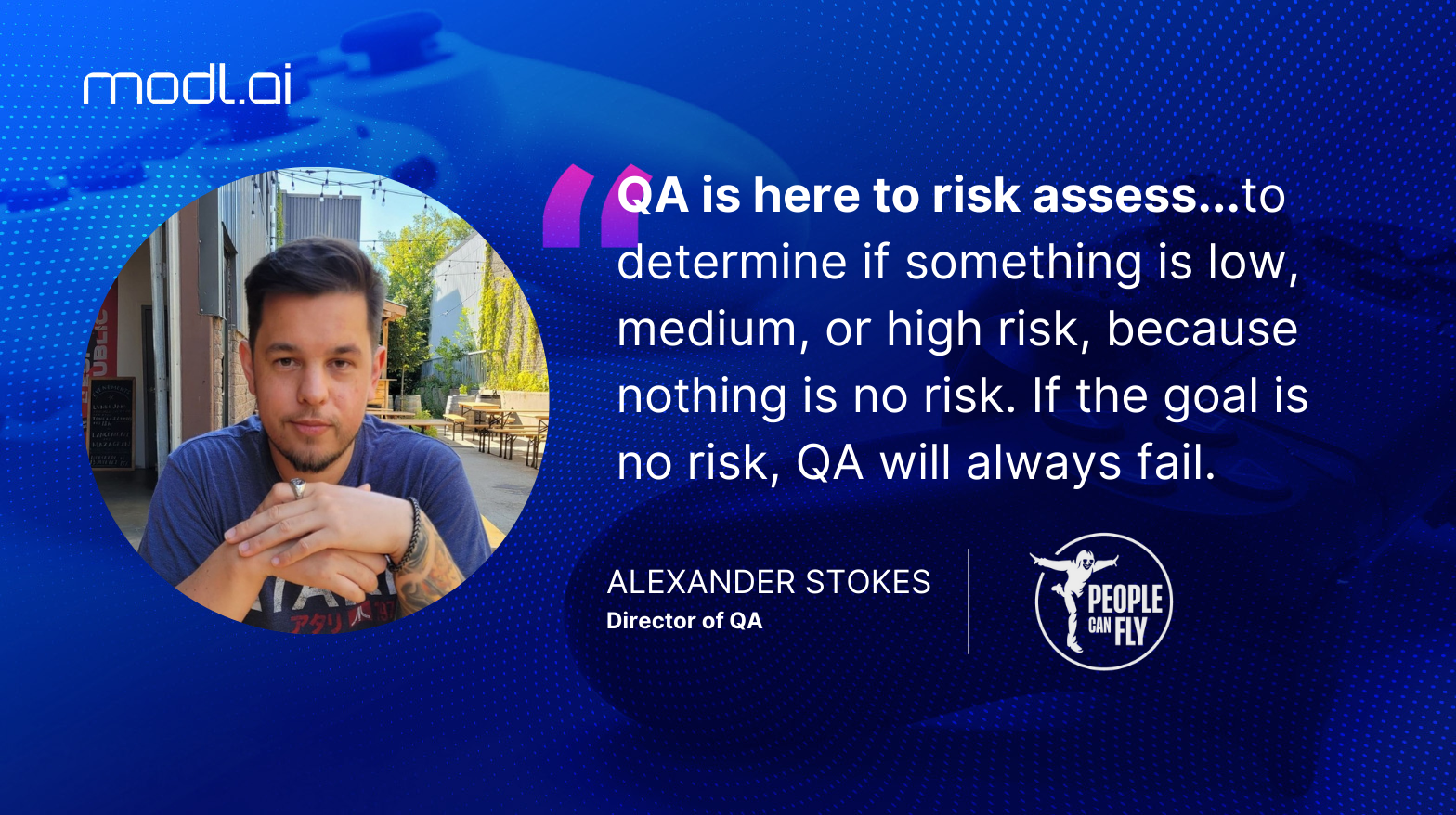Insight | Interview
Games QA and the Creative Process: Organizational Insights From Rob Sandberg
Studios can streamline their production pipeline while enriching gameplay experiences with just a few QA enhancements.
April 3, 2025

Studios can streamline their production pipeline while enriching gameplay experiences with just a few QA enhancements.
Game development has always been a mix of artistry and technology, but true success comes from process innovation. Rob Sandberg, a 30-year veteran of game production and live operations, has seen the industry evolve over his storied career. His experience working with teams like Product Madness and Reliance Games has given him a unique perspective on where studios succeed and where they fall short.
His core philosophy is that QA and production should be integral to the creative process, not just a technical hurdle to clear before launch. Modl.ai CEO Christoffer Holmgård sat down with Sandberg for a wide-ranging discussion on his philosophy and how automation is helping developers push the envelope. Read on for a selection of key takeaways, or watch the complete interview below.
Key Takeaways
- Shift QA left: Integrate QA early in development to prevent issues before they escalate.
- Automate intelligently: AI-powered automation streamlines production workflows and unlocks more development cycles.
- Foster collaboration: Stronger connections between QA and other developers lead to better products.
- Treat QA as a strategic asset: Quality isn’t just about bug fixing. It enhances creativity, informs player experiences, and drives revenue.
Shift QA Left: From Bottleneck to Business Driver
AI is increasingly finding its place in games QA, but its real strength lies in working alongside human testers rather than replacing them. By automating repetitive and routine testing tasks, AI enables QA professionals to focus their efforts on areas that require critical thinking, creativity, and problem-solving. This integration boosts efficiency and enhances the overall experience of QA work, making it more engaging and fulfilling for testers.
“The definition of QA isn’t finding bugs, it’s preventing bugs. The earlier that you can have QA as part of your creative process — whether that be game design document reviews, whether that be part of the pitching process, whether that be early playtesting of prototypes — the better.”
Some of the most successful studios have embraced this philosophy. Riot Games, for example, integrates QA throughout its development cycle, embedding testers directly into feature teams to catch issues as early as possible. This approach helps prevent costly last-minute fixes and ensures that gameplay quality remains a priority from day one.
With AI-driven tools, teams can take this even further. Automated bots can continuously test new builds, identifying crashes, performance issues, and unintended gameplay behaviors long before they reach human testers. This ensures that QA isn’t a bottleneck, it’s an accelerator.
Automate to Accelerate: Speed Up Without Sacrificing Quality
Speed and quality are often seen as opposing forces. But in today’s live service environment, where constant updates drive player engagement and revenue, studios must be able to move quickly without breaking things. To Rob, baking a commitment to quality into a studio’s mission statement is central to achieving those goals.
“Having a culture of quality in your mission statement, and living and breathing that, is critical to success. And what I mean by a ‘culture of quality’ is where everyone in the studio is accountable for quality. They may not be accountable for testing the game and validating these tests… but learning to think like a developer and understanding the value of understanding exactly what a feature is from the very core.”
AI-driven automation is the key to this balance. Ubisoft has invested heavily in automated testing, using machine learning models to identify gameplay anomalies, catch performance issues, and streamline QA workflows. This reduces the workload on human testers and ensures that game-breaking bugs don’t make it into live builds.
Rob has also seen this firsthand. At Product Madness, QA and automation were prioritized early in development, leading to dramatically shorter release cycles. By shifting left and integrating automated testing, the studio reduced its release timeline from nearly a month to just a few days — a critical advantage in the fast-moving world of live service games.
Treat QA As Part of the Creative Process
QA should never be just a mechanical process. The best studios treat their testers as creative partners, leveraging their deep knowledge of the game to refine mechanics, balance, and overall player experience. And there’s good reason to. QA testers spend thousands of hours scouring a game’s nooks and crannies looking for bugs. That gives them a unique understanding of the player, Rob says, and by extension more to contribute to the game creatively.
“Everybody in product management should understand what the acceptance criteria are. If anything, they’re the ones who should be learning to write acceptance criteria. So then the QA can then take that acceptance criteria from a product perspective, and then they can focus less on that and focus more on the product.”
Marrying the QA and creative process has a long history of churning out positive results. Ken Birdwell, a former engineer for Valve, once detailed the “cabal” approach the studio took when developing Half-Life. Rather than using QA as a tool to merely sniff out bugs, Valve allowed a small team to dig into the game and make recommendations on how to polish and expand on Half-Life’s “fun” features, which eventually resulted in the groundbreaking FPS we know today.
QA Is a Competitive Advantage
It’s easy to measure downloads, DAUs, and revenue. But quality is a hidden driver behind all of these metrics. Rob puts it, “Quality is an unseen KPI. Players don’t always notice it, but it directly impacts engagement and revenue.” Fail to keep quality high, and you wind up churning players.
“I don’t think we’ll ever replace human behavior… that kind of intuitiveness and creativity. AI bots can explore within learned behaviors, but players act unpredictably. It’s the human testers who can think outside the box, break the system in ways no AI could, and offer insights into how the game truly feels.”
Studios that invest in robust QA see higher retention, stronger player trust, and increased monetization. In the free-to-play space, even a minor bug in a live event can cost millions in lost revenue. Automation helps avoid these pitfalls by ensuring that updates are thoroughly tested before they go live.
Let QA and Automation Evolve Together
Game development is evolving rapidly, and studios that embrace innovation in QA and automation gain a decisive edge. As Sandberg highlights, integrating QA early, leveraging AI-driven automation, and treating testers as creative partners are key strategies for improving quality, efficiency, and player experience.
With modl:test, studios can seamlessly shift QA left, reduce release times, and ensure their games meet the highest standards all without overburdening their teams. If you’re ready to transform your QA process and accelerate development without sacrificing quality, explore how modl.ai’s AI-powered solutions can help. Click here to learn more.


